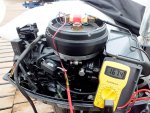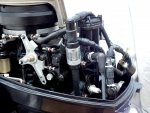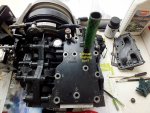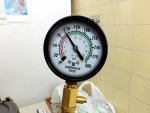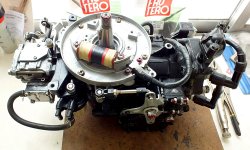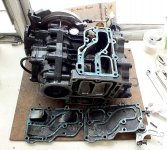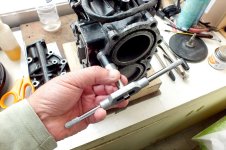Sea Rider
Supreme Mariner
- Joined
- Sep 20, 2008
- Messages
- 12,345
800 Hour Preventive Maintenance.-
Taking advantage that lower leg and powerhead were down decided to strip middle section, it?s a matter of removing shift rod and 4 bolts that secures it to swivel bracket. Removed upper and lower steering shaft?s bushings, wiped old grease, lubed with fresh grease and assembled back lower leg. Lower gasket cane out in one piece due to sitting powerhead on top of a well greased gasket done on previous restoration.
Lower powerhead was found very clean due to periodic CRC decarbon spray application through carb, all water paths were found clean, a long water flush with fresh water after salt water use accounts for this.
Thermostat was removed and polished along a new gasket lightly greased and bolted back.
Head gasket & exhaust cover bolts were removed individually, cleaned, lightly greased, put back and torqued to specs. This will assure fast removal next time and forget all about unwanted thread seizures due to salt formations around internal head gasket's bolt bodies. New head gasket didn?t made it on time for the 800 hour full maintenance, so current one is sill good to go for next 100 hours.
Impeller housing was removed, liner was well polished to smooth finger tip perfection. This is the original impeller that came with OB, looks mint. Water pressure is outstanding, impeller keeps peeing for 15 seconds after OB has come to a stop.
Changed gear oil, now with Amalie 80-90 High Viscosity grade, a new alum 3 blade 8.5 pitch will power combo, replaces a 8 pitch prop.
All grounds and electrical components terminals were polished to shinny condition, this assures that all electrical components will do their homework right, don?t fail any time soon and last long. Two new NGK spark plugs well gaped were added.
Lower leg anodes & trim tab were polished to perfection, were extremely salted and pitted.
Powerhead was flushed for 15 min with high water pressure with hose through upper flushing port, should get rid of any salt formation building up inside.
A Dremel 700 rotary tool along my fab 5 allies helped removing gaskets leftovers, polishing & shinning with toothpaste different metal parts to new condition. Total time invested : 14 hours. Cost $ 10.00 and some cold ones...
Happy Boating
Taking advantage that lower leg and powerhead were down decided to strip middle section, it?s a matter of removing shift rod and 4 bolts that secures it to swivel bracket. Removed upper and lower steering shaft?s bushings, wiped old grease, lubed with fresh grease and assembled back lower leg. Lower gasket cane out in one piece due to sitting powerhead on top of a well greased gasket done on previous restoration.
Lower powerhead was found very clean due to periodic CRC decarbon spray application through carb, all water paths were found clean, a long water flush with fresh water after salt water use accounts for this.
Thermostat was removed and polished along a new gasket lightly greased and bolted back.
Head gasket & exhaust cover bolts were removed individually, cleaned, lightly greased, put back and torqued to specs. This will assure fast removal next time and forget all about unwanted thread seizures due to salt formations around internal head gasket's bolt bodies. New head gasket didn?t made it on time for the 800 hour full maintenance, so current one is sill good to go for next 100 hours.
Impeller housing was removed, liner was well polished to smooth finger tip perfection. This is the original impeller that came with OB, looks mint. Water pressure is outstanding, impeller keeps peeing for 15 seconds after OB has come to a stop.
Changed gear oil, now with Amalie 80-90 High Viscosity grade, a new alum 3 blade 8.5 pitch will power combo, replaces a 8 pitch prop.
All grounds and electrical components terminals were polished to shinny condition, this assures that all electrical components will do their homework right, don?t fail any time soon and last long. Two new NGK spark plugs well gaped were added.
Lower leg anodes & trim tab were polished to perfection, were extremely salted and pitted.
Powerhead was flushed for 15 min with high water pressure with hose through upper flushing port, should get rid of any salt formation building up inside.
A Dremel 700 rotary tool along my fab 5 allies helped removing gaskets leftovers, polishing & shinning with toothpaste different metal parts to new condition. Total time invested : 14 hours. Cost $ 10.00 and some cold ones...
Happy Boating
Last edited:




















